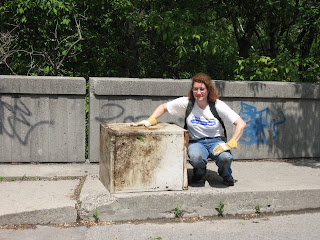
Some of the maps of the project area at the open house
Two weeks ago I attended an open house for a new Class Environmental Assessment that the city has launched for the lower Don Valley. The project will look into various options to manage runoff from the Don Valley Parkway. The open house itself was pretty low-key. I counted only about two dozen attendees at most. Some people were expecting a presentation followed by a Q&A but there were only display boards available to look at with some staff on hand to answer questions. Presumably, there will be a presentation when the consultants have have studied the issue and reported back to the city.
The open house encouraged people to fill out a comment sheet on the project (The commenting period ends July 4 so if you're want to put your 2 cents worth in you need to send it in soon). I decided to post my comments here as well as a few handy maps to guide you. There were three major sites and several smaller enhancements being looked at. I will look at each one in turn.

Todmorden Mills (aka Site 75)
This site already has three sizable ponds and associated wet areas. These are fed by springs that occur at the base of the slope throughout the forest. The ponds are all well established and functioning well. My comments to the project:
Very little modification should be performed on the existing pond. The wetland is performing nicely as habitat for wetland plants and animals of all kinds. Any work to deepen or widen the existing pond will significantly damage or impair its current biological function.
Stormwater management at this site should be targeted toward new treatment ponds, specifically a new pond located in the vacant cloverleaf located just south of the existing pond. Stormwater can go through primary treatment here before it is allowed to drain into the existing system of wetland ponds.
While a “Do Nothing” approach means that there will be no improvement in water quality, it should be noted that water quality is already high.

Site 83
This site is a sliver of the valley that was orphaned when the DVP was built. My comments:
This is a remote site that is cutoff from the rest of the valley. It has little current value and is rife with non-native invasive species. Either a wet pond or a constructed wetland are suitable here. A wetland may be better since it won't require on-going maintenance that a wet pond would require.

Site 132/135
This site is entirely within the cloverleaf that makes up part of the offramps from the DVP to Don Mills Rd. These isolated areas make them ideal for stormwater management. An old wetland was created here some time ago. My comments:
Both of these locations are relatively large so it may be possible to combine some wet pond and wetland functions on both sites with one leading into the other. If this isn't possible then either type is suitable. There is an existing wetland in the northern site. This could be enhanced as a wetland but its function shouldn't be impaired by trying to turn it into a wet pond.
Minor Sites
These are a collection of small sites that are downslope from existing outfalls that issue between the southbound DVP lanes and the Don River. My comments:
Care should be taken to ensure that any embayments be constructed so as to minimize loss of existing trees and shrubs. The location of the Enbridge natural gas pipeline needs to be ascertained prior to any design proposals as it runs through many of the minor sites being studied.











